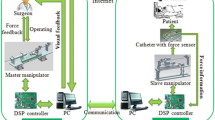Abstract
Minimally invasive surgery (MIS) is a less invasive procedure compared to traditional open surgery. It usually involves laparoscopic devices and remote control manipulation instruments comprising an endoscope for indirect observation of the surgical field. Interventional radiology (IVR) is one of the MIS methodologies. The IVR procedures include diagnosis such as angiograms, and treatment. The IVR procedures use small tubes called catheters, which are inserted through the body cavity or blood vessel to the treatment area. The IVR procedures lead to the risk of X-ray exposure to surgeon since the procedures is using the digital subtraction angiography device to get clear image of the patient blood vessel. Therefore, we have developed a foolproof tele-operated system to guide the catheter. Hence, the reliability in IVR procedure is crucial. The system is based on a mechatronic design methodology characterized by a principle solution specified in CONSENS® (CONceptual design Specification technique for the ENgineering of complex Systems). This principle solution serves as a basis for the first analysis and verification on the system level. Further, the proposed concept of control system can also be re-used in the other foolproof guidance systems.











Similar content being viewed by others
Abbreviations
- MIS:
-
Minimally invasive surgery
- IVR:
-
Interventional radiology
- DSA:
-
Digital subtraction angiography
- ER fluid:
-
Electro Rheological fluid
References
Muenchhof M et al (2009) Fault-tolerant actuators and drives—structures, fault detection principles and applications. Ann Rev Control 33(2009):136–148
Uchida H, Yamada R (eds) (2002) IVR manual,1st edn. Igaku Shoin, Tokyo
Ma X, Guo S et al (2011) Development of a novel robot-assisted catheter system with force feedback. In: IEEE international conference on mechatronics and automation, ICMA, pp 107–111
Tercero Villagran CR, Ikeda S, Fukuda T et al (2007) Catheter insertion path reconstruction with autonomous system for endovascular surgery. In: Proceedings of the 2007 IEEE international symposium on computational intelligence in robotics and automation, Jacksonville, FL, USA, 20–23 June 2007
Arai F, Fujimura R, Fukuda T, Negoro M (2002) New Catheter driving method using linear stepping mechanism for intravascular neurosurgery. In: Proceedings of the IEEE ICRA, Washington DC, USA
Guo S, Xiao N, Gao B, Tamiya T, Kawanishi M Internet based remote control for a robotic catheter manipulating system. In: Proceedings of the 2012 ICME international conference on complex medical engineering, 1–4 July, Kobe, Japan
Tiwana MI, Redmond SJ, Lovell NH (2012) A review of tactile sensing technologies with applications in biomedical engineering. Sens Actuators A Phys 179:17–31
Kanagaratnam P, Koa-Wing M et al (2008) Experience of robotic catheter ablation in humans using a novel remotely steerable catheter sheath. J Interv Card Electrophysiol 21(1):19–26
Zandsteeg CJ, Bruijnen DJH, van de Molengraft MJG (2010) Haptic tele-operation system control design for the ultrasound task: a loop-shaping approach. Mechatronics 20:767–777
Gausemeier J, Frank U, Donoth J, Kahl S (2009) Specification technique for the description of self-optimizing mechatronic systems. Res Eng Des 20(4):201–223
Feng W, Chi C, Wang H, et al (2006) Highly precise catheter driving mechanism for intravascular neurosurgery. In: Proceedings of the 2006 IEEE international conference on mechatronics and automation, 25–28 June, Luoyang, China
Ide M, Komeda T et al (2008) Development of the force reflecting master slave system for catheter guide without force sensor. In: 26th Nippon Robot Gakkai Gakujyutsu Kouen Gaiyoushuu, pp 175–176
Deml B, Ortmaier T, Seibold U (2005) The touch and feel in minimally invasive surgery. In: HAVE2005—IEEE international workshop on haptic audio visual environments and their applications, Ottawa, 1–2 Oct 2005
Hara M, Kung YM, Huang J, Yabuta T (2006) Basic study on sensory aspects of a master/slave system for force telecommunication. In: Proceedings of the 2006 IEEE/RSJ international conference on intelligent robots and systems, 9–15 Oct 2006, Beijing, China, pp 1706–1711
Takashima K, Shimomura R et al (2007) Contact and friction between catheter and blood vessel. Tribol Int 40:319–328
Ham R, Sugar TG, Vanderborght B, Hollander K, Lefeber D (2009) Compliant actuator designs: review of actuators with passive adjustable compliance/controllable stiffness for robotic applications. IEEE Robot Autom Mag 16(3):81–94
日本ME学会編,医用電子生体工学ME辞典,コロナ社 1999, pp 613 (in Japanese)
Noor Ayuni CZ, Low CY, Komeda T (2010) Mechatronic design for a fail-safe catheter guide system. In: Proceedings of ASME congress & exposition IMECE2010, Vancouver, BC, CA, 12–18 Nov, ISBN 978-0-7918-3891, IMECE2010-37634
Acknowledgments
The specification technique CONSENS® was developed in the course of the Collaborative Research Center 614 “Self-Optimizing Concepts and Structures in Mechanical Engineering” funded by the German Research Foundation (DFG) under grant number SFB 614. This research was initiated by the Research Organization for Advanced Engineering in Shibaura Institute of Technology, Japan and later supported by the Ministry of Higher Education Malaysia under the grant number 600-RMI/ST/FRGS 5/3/Fst (256/2010) and 600-RMI/ERGS 5/3 (23/2011).
Author information
Authors and Affiliations
Corresponding author
Rights and permissions
About this article
Cite this article
Che Zakaria, N.A., Komeda, T., Low, C.Y. et al. Development of foolproof catheter guide system based on mechatronic design. Prod. Eng. Res. Devel. 7, 81–90 (2013). https://doi.org/10.1007/s11740-012-0430-6
Received:
Accepted:
Published:
Issue Date:
DOI: https://doi.org/10.1007/s11740-012-0430-6




